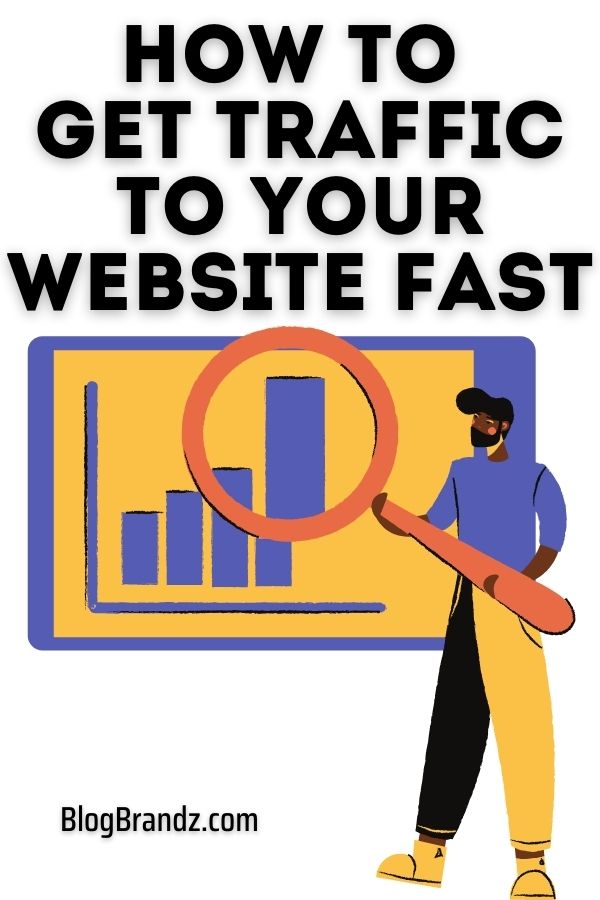
Can you increase website traffic if you don’t have the time to create new content? Here’s how to get off the content hamster wheel and get more website visitors.
It’s no secret that you need consistent web traffic to build a successful online business. Most digital marketers stress the need to create new content to increase website traffic.
But what if you don’t have the time or resources to do that? While most businesses focus on creating new blog content to increase web traffic, there are other ways to get more visitors to your site.
In this post, we’ll discuss some simple techniques that you can use to get off the content hamster wheel, increase blog traffic, and get more website visitors without creating new content.
Contents
7 Tips to Get Website Visitors WITHOUT Creating New Content
Here are some tips that will help you boost traffic without creating new content. Whether you’re short on time or just don’t feel like writing, these methods will help you get the website visitors you need.
#1. Update old content
Updating old content is an SEO best practice that all bloggers need to do to keep their content fresh and relevant for their website visitors and boost organic website traffic.
It’s important to keep revising and updating the information in your blog posts to reflect any changes that have happened since it was first published while making sure that it is still accurate.
If you have old blog content that’s no longer up to par, you need to update it with fresh information and new insights. This will make it more appealing to your website visitors, and also give you something new to promote on social media and other channels.
There are a few ways to refresh and update old blog content so that it feels fresh and new again. Here are some things you can do to update old content:
- Update dates, such as 2020, to the latest year, where possible. If the content is outdated, you can update it with the latest information and add new information or perspectives to the content.
- If you have an article or blog post that’s been sitting around for a while and isn’t getting much traction, consider updating it with the latest statistics, or a case study. You can also combine PLR content with your old content to make it fresh and new.
- Check for new studies or research data that might support your content and tweak it accordingly. You can add tables and quotes or rewrite the content to make it more accurate or up-to-date.
- Use online paraphrasing tools that rewrite sentences online to rewrite and repurpose old content into new and unique articles that you can use in multiple ways.
- You can add new images or links to the content. If you have any old images or infographics, update them with new, more recent visuals. You can also redesign the content formatting to make it more visually appealing.
- Update the headline and metadata of the post with the most relevant keywords. This will help improve your content’s ranking in search engines and attract more readers over time.
- Create a content schedule to update your old blog content regularly and ensure that your old content is still being found by potential customers or readers.
These methods to refresh and update old blog content will help you boost blog traffic and get more website visitors without having to write new blog posts. If you don’t have the time to do all this yourself, hire a content writer to help you update your old blog posts.
#2. Repurpose your old content
Repurposing content, or content recycling, is the practice of reusing all, or elements of, existing content in order to expand that content’s reach.
Repurposed blog content can be transformed into a new format, like turning a blog post into an infographic. Content repurposing tools can help you repurpose and reuse content that you’ve already spent time and money creating.
There’s no limit to the ideas you can come up with for repurposing blogs. Here are some ways you can go about repurposing old blog content.
- First, use tools like Google Analytics and Google Search Console to track which pieces of content are most popular.
- Then repurpose the most popular pieces of content into different formats and create new versions of the content, such as turning it into a video for YouTube, or a PPT for Slideshare.
- You can also break up old content into smaller segments and use it as social media content.
- Create an infographic to share on sites like Pinterest and drive traffic back to the original blog.
- If you have a lot of old video content, you can create new videos by editing clips or creating a vlog-style commentary.
- You can also include old blog content as part of a larger project, such as an eBook or online course.
There are many ways to repurpose old blog content, but ultimately you need to focus on the kind of content formats and distribution channels that will bring in traffic and that work best for your business.
#3. Re-share old content
By re-sharing old content, you can grow your social media following, reach a new audience, keep your existing audience engaged, sustain web traffic, get more website visitors, and promote and share evergreen content.
Here are a number of ways to re-share your old blog content:
- The simplest way is to share your old content again manually on your social media platforms or to bookmark it on a large number of bookmarking sites to boost your social media engagement.
- Make sure you share your content on Twitter, Facebook, LinkedIn, and any other social media platforms you use. You can also use social sharing tools to help you track your social media reposting schedule.
- If you want to automate this process, you can install WordPress plugins that automatically re-share evergreen content on your social channels.
- Create new Pinterest pins for old blog posts and share them on multiple Pinterest boards. Learn how to use Pinterest to boost your Pinterest traffic and visibility.
Make sure you have social media sharing buttons on your blog posts. This will make it easier for website visitors to share your blog content on their social media accounts and help you gain website traffic.
#4. Build links to old content
Link-building in SEO is a very important step in boosting your Google search rankings and building website traffic over the long term.
If you have no experience in link-building, you can use SEO tools or hire an SEO specialist to help you do this more efficiently. Here are a few things you can do to help build links to your old content:
- Reach out to bloggers and journalists
Reach out to bloggers and journalists who have covered similar topics in the past. Let them know about your updated blog content and see if they’re interested in covering it.
You can also send them a link to the content itself and use SmartWriter’s AI email outreach tools to create 1000s of personalized emails that generate 8X more responses in minutes.
You can also use tools like Ninja Outreach to create effective influencer marketing campaigns by filtering through millions of influencers’ insights to find the one that captures your target audience’s attention. Then reach out to them and pay them to share it with their audience.
- Broken link building
Broken link building is an advanced link-building tactic that involves reaching out to webmasters who have broken links in their content (that point to content similar to yours), and asking them to replace the broken link with a link to your freshly updated blog post.
Again, if you’re not experienced with link-building for SEO, it’s best to reach out to an SEO freelancer or SEO agency to help you implement this.
- Build internal links to old articles
Internal linking is a very important SEO strategy to keep visitors on your website longer while helping boost the ranking of your content. Check out the tips to boost internal linking in this SEO guide, and get more link-building and outreach tips for your link-building campaign.
- Guest blog on high-traffic websites
Guest blogging is not just a great way to get your name and your work out there in front of a large audience, but by writing for high-traffic websites, you can reach a wide variety of readers and potential customers and build referral traffic to your website.
Guest blogging also offers the opportunity to build relationships with other bloggers and thought leaders in your industry, develop a more robust online presence, and boost your search engine rankings.
You can get started by publishing guest posts on LinkedIn, Medium, Blogger, and WordPress.com, and hiring link-building freelancers to guest blog for your website on other high-traffic websites.
Link-building is an essential step to improving your website rankings and traffic, but keep in mind that it takes time to generate backlinks, and while it may not get more website visitors immediately, it will boost your website’s domain authority and rankings over time.
#5. Pay for content syndication
Learn how to increase blog traffic fast with content syndication – a quick and easy method to get website visitors that only requires a bit of creativity and some strategic planning.
You can create unique content for syndication by using article rewriting tools to rewrite old content and pay to promote it on content syndication platforms or through content syndication services like the ones below:
FATJOE’s content syndication and distribution service will syndicate your existing blog posts and articles across premium media outlets, giving back value through a mix of no-follow and do-follow links.
WhitePress® helps you publish your articles on more than 38,000 websites and blogs using a simple search engine for a fair price. You can copy and paste your own article or order a new one from WhitePress journalists and copywriters.
#6. Build a Facebook Group
Launching a Facebook group is one of the leading ways to create brand credibility online, build your email list, and network with your audience. Facebook group posts get more visibility in the newsfeed than Page posts.
However, managing your group successfully can be complex, and growing your community requires in-depth knowledge of how to make the platform work to your advantage.
A successful Facebook group that constantly drives engagement between members – all while maintaining high levels of interest among followers so they don’t drift away – will help you build an engaged community and send more traffic to your website.
In the Mastering Facebook Groups course, you’ll learn how to launch, grow, monitor, and monetize your Facebook group.
This course will teach you how to create a thriving Facebook group from scratch, attract a high-quality audience, measure the success of your group as you grow, outsource community management to freelancers, and monetize your online community so you can make a profit from your efforts.
#7. Run Facebook Ads
One of the fastest ways to increase traffic fast is to use Facebook ads. By targeting Facebook users who are most likely to be interested in what you have to say or sell, you can drive a significant amount of traffic to your content.
With Facebook’s paid advertising platform, you can target specific demographics and interests, so you need to clearly establish what your goals are and who your target audience is. You should also set a budget for how much you’re willing to spend and write creative and catchy ad copy that resonates with your audience.
Facebook Ads can be an effective way to reach a large number of people who are more likely to be interested in your content. The Become A Facebook Ads Professional course will teach you how to leverage Facebook Ads to start converting more clients and making more sales.
You’ll learn all about the basics of social media marketing, going into depth on creating and optimizing your Facebook Ads, targeting and retargeting the correct audiences, generating more leads, and even building your own Facebook chatbots to dramatically increase conversion.
Here are a few tips to use Facebook Ads effectively:
- Make sure your ad targets the right audience by targeting people based on their interests, demographics, and even location.
- Use eye-catching images and videos to grab people’s attention and make them more likely to click on your ad.
- Use compelling copy in your ad headline and body text to persuade people to click on your ad and visit your website.
- Make sure your Facebook ad directs people to a relevant landing page on your website to ensure that visitors take the desired action.
- Monitor and track your results and adjust as necessary.
Traffic is the lifeblood of your blog. By making small changes in how you promote your blog and following these tips to boost website visitors, you can learn how to increase blog traffic while getting off the content hamster wheel.
Be wary of any schemes by companies that drive traffic to your website by helping you buy website visitors or website hits, or claim to get millions of traffic to your website with no effort.
This is most likely the kind of traffic that will not convert and is a waste of money. If you’re looking for legitimate ways to increase blog traffic without creating new content, try using the tactics above.
For more genuine tips on how to increase website traffic organically, learn how to do SEO with these bloggers’ SEO tips, so you can get more targeted website traffic that will convert into leads and customers.
Equip yourself with all the knowledge you need to take your web traffic from zero to thousands of quality visitors in this Web Promotion program.
SEO & Link-Building Tips
- How to outsource SEO services to an SEO specialist
- How link building in SEO can boost Google Search ranking
- SEO tips for bloggers: Learn SEO basics with this SEO guide
- Best sentence rewriter tools to rewrite sentences online
- Best AI writing generator tools for writing AI content
- Get SEO certification free with the best free SEO courses
- How to start creating an online presence for your business
© 2022 – 2023, Priya Florence Shah. All rights reserved.
Priya Florence Shah is a bestselling author and an award-winning blogger. Check out her book on emotional self-care for women. Priya writes short stories and poetry and chills with her two-legged and four-legged kids in her spare time.
Discover more from Business & Branding Tips
Subscribe to get the latest posts sent to your email.










